Los Angeles is more than Hollywood stars. From hikes with killer views to beaches straight out of a rom-com, here are 10 must-do LA experiences for Filipino travellers or any wanderers in general!
When In Barcelona: My Itinerary and Easy DIY Travel Guide
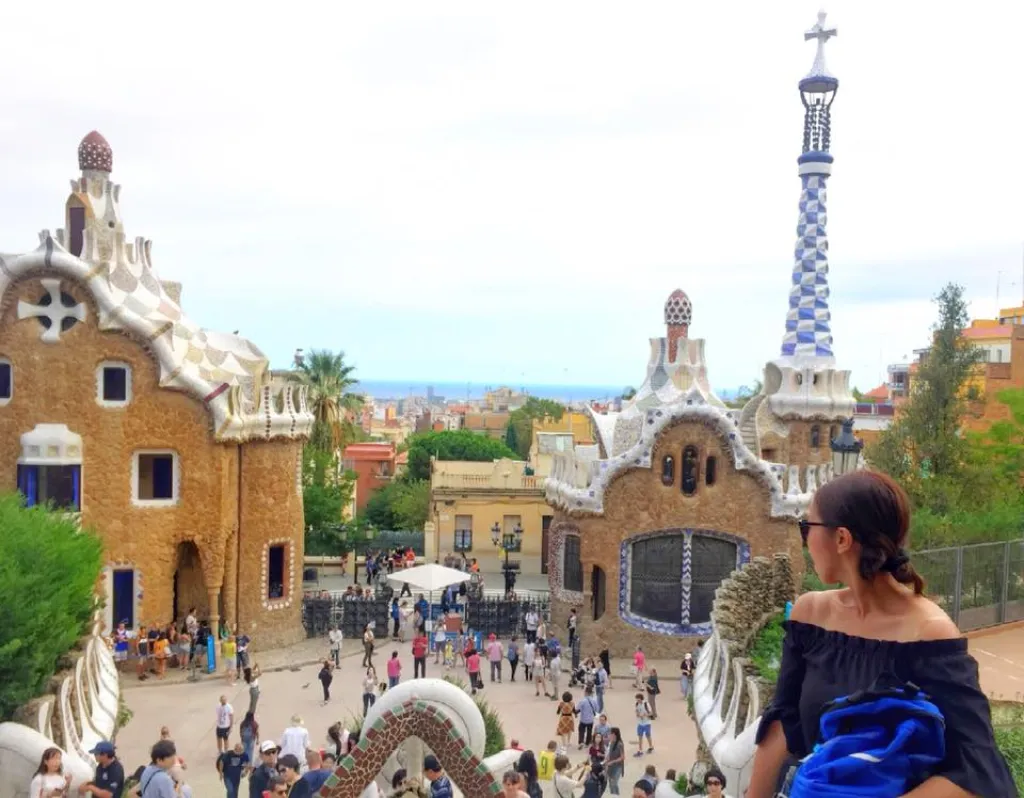
Contributed by Shelly Viajera Travels
Barcelona (BCN) is a city located northeast of Spain and the capital of the Catalonia region. It’s the second most populous city in Spain with around 1.6 million people. While Spanish (ESP) is the dominant language in Spain, Catalán (CAT) is another language widely spoken in Barcelona. It’s also spoken in the rest of the Catalonia region.
Also read: Around Europe: A 101 Guide For Solo Female Travellers
Why go to Barcelona?
Seated in the coastal area, some people fondly call this city “Sunny Barcelona” for having a warmer climate than other cities in Spain. The best time to visit Barcelona is in September, a season that marks the end of Summer and the start of Autumn.
I went to Barcelona in September when I truly had the best time. Aside from the variety of places to visit, the city is culturally diverse and I find Catalonians more welcoming than expected. Given a chance to go back, I’d definitely choose Barcelona again.
What to see in Barcelona
I’d like to share with you the must-do and must-see places in the city, which I grouped by their proximity to each other. Barcelona may be huge, but its public transportation especially the BCN metro, tram, and bus are very accessible and easy to be familiarized with. It won’t be a problem even if you choose to move around on your own.
Day 1: Sagrada Familia, Hospital de Sant Pau, Park Güell, and Bunkers del Carmel
1. Sagrada Familia

Other names: Basílica i Temple Expiatori de la (CAT), Basilica and Expiatory Church of the Holy Family (EN)
There’s no better way to start exploring Barcelona than to visit the most famous structure in the city: The Sagrada Familia. It’s a gothic style Catholic church by renowned Catalán architect Antoni Gaudi. Its construction began as early as 1882. However, Gaudi unfortunately, passed away in 1926, a time when his masterpiece wasn’t even halfway finished. Up to now, it’s still in the works but it’s set to finish construction in 2026 (yes, eight years more!)
While there’s an obvious construction site outside, the Sagrada Familia looks more polished inside. The white pillars and stained glass windows are truly works of art.
To enter the Sagrada Familia, I highly recommend buying the ticket online to avoid the queue and to get it for a cheaper price. Note that entry is timed (which is very common among tourist sites in Europe). This means you have to be at the entrance based on the time frame you choose. Otherwise, they won’t let you in. Sagrada Familia’s entry time frames are 9am-12pm, 12pm-3pm, and 3pm-5.30pm.
The best way to get to the Sagrada Familia is by metro. There’s actually a dedicated station to it (Sagrada Familia station) served by BCN metro lines 2 and 5.
Price: €15
Operating Hours:
November-February: 9am-6pm
March: 9am-7pm
April-September: 9am-8pm
October: 9am-7pm
December 25, 26, January 1-6: 9am-2pm
2. Hospital de Sant Pau

Coming from Sagrada Familia’s front, walk straight on Avenida de Gaudi (Gaudi Avenue) to get to Hospital de Sant Pau, a known hospital-turned-museum in Barcelona.
So why include a hospital in the itinerary? For one, it has a one-of-a-kind architecture, props to modernist architect Lluís Domènech i Montaner (not by Gaudi, like most people thought it was). It was also named a World Heritage Site by UNESCO for its cultural significance.
There’s a museum inside called the Art Nouveau Site that includes access to another notable structure, the Sant Salvador Pavilion. Entrance fee applies.
Price: €14 (self-guided adult ticket)
Free entrance: April 23, September 24, and every first Sunday of the month
Operating Hours:
November-March
Mondays-Saturdays: 9.30am-4.30pm
Sundays and holidays: 9.30am-2.30pm
April-October
Mondays-Saturdays: 9.30am-6.30pm
Sundays and holidays: 9.30am-2.30pm
3. Park Güell
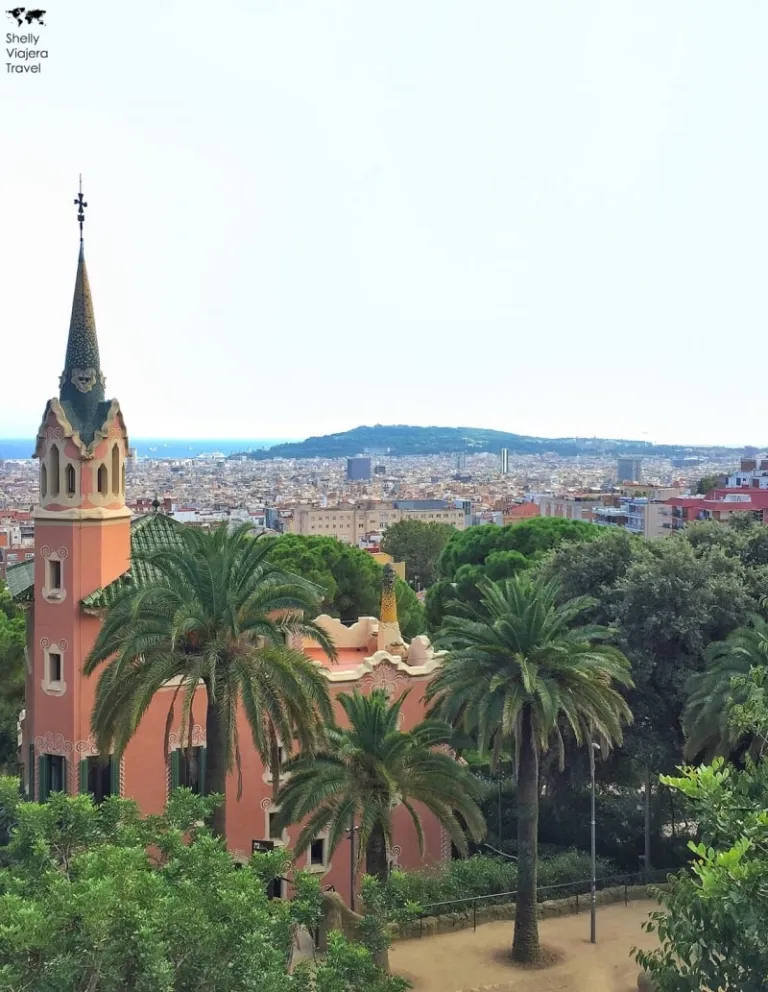
Other names: Parc Güell (CAT) / Parque Güell (ESP); Güell is pronounced as “gwey”
Either take bus #92 at the corner of Avenida de Gaudi and Castillejos, or walk 25 minutes to reach Parc Güell, a hilltop nature park created by Antoni Gaudi.
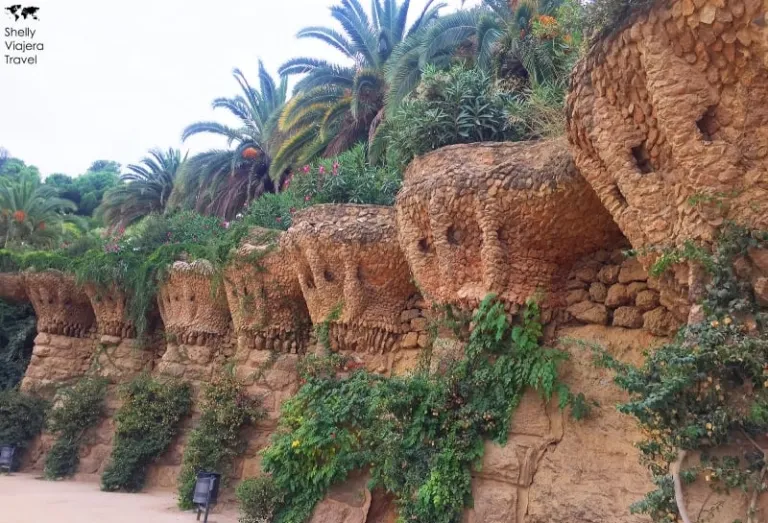
The area could’ve been a housing project for the upper class by Gaudi, though it didn’t push through. It only has two houses completed. Instead, it got turned into a park that displays Gaudi’s vision of a house: unique entrance gates, stairways, and terraces where most of which were decorated with mosaic art. The park also features Gaudi’s civil engineering ideas that include roadways, paths, and viaducts.

The highlight of the park is the Monumental Zone that gives access to the Dragon Stairway, the 2 porter lodges, and others. Note, however, that a portion of it is under construction until the end of 2018 (called the Nature Square / Greek Theater). Entry is timed and the interval is every 30 minutes. Tickets can also be bought online for a cheaper price.
The rest of Parc Güell is free of entrance, which I suggest you visit after exploring the Monumental Zone. Give at least two hours to explore the park. Climb to the peak of the park for a breathtaking view of the city.
Prices:
Online: €7.50
Counter fee: €8.50
Operating Hours:
It’s open all year round. Check the website for the updated first and last entry hours.
4. Bunkers del Carmel
Moving farther and higher, cap off the day by climbing the Bunkers del Carmel, a former defence area that was significant during the Spanish Civil War in the 1930s. Back then, it was mounted by guns to strategically shoot against aerial attacks.
What’s left now are ruins of the defensive walls and slabs of concrete for sitting. More than a historical landmark, people visit the Bunkers del Carmel for the panoramic view of Barcelona. It’s the best place to catch the sunset.
Entrance: Free
Operating Hours: Open all the time
Day 2: Arc de Triomf, Plaça de Catalunya, La Rambla, La Boquería, Barcelona Cathedral, Gothic Quarter
1. Arc de Triomf
Other names: Arco del Triunfo (ESP)
If Paris has Arc de Triomphe, then Barcelona has a version of it too, called the Arc de Triomf. Go for a quick stop to take photos of this arch as it’s a landmark in Barcelona.
The Arc de Triomf is a 30-metre red brick monument that was built as an entrance arch of the Barcelona Universal Exposition that kicked off in 1888. It’s a remarkable event in Spain’s history as it’s the country’s first international World Fair.
2. Plaça de Catalunya
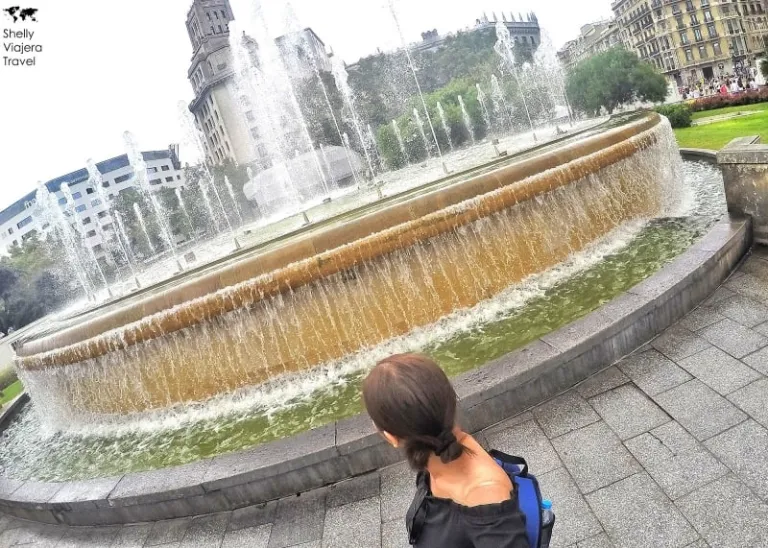
Other names: Plaza de Catalunya (ESP) / Catalonia Square (EN)
The Plaça de Catalunya is a public square in Barcelona with fountains and statues. It’s also where you’d probably find the biggest flock of doves which has become an attraction, especially to kids.
Many people pass by Plaça de Catalunya since the Plaça de Catalunya metro station is a main station and transfer hub in Barcelona. The area is also the so-called centre where the old district (Ciutat Vella) and new district (Eixample) meet.
3. La Rambla
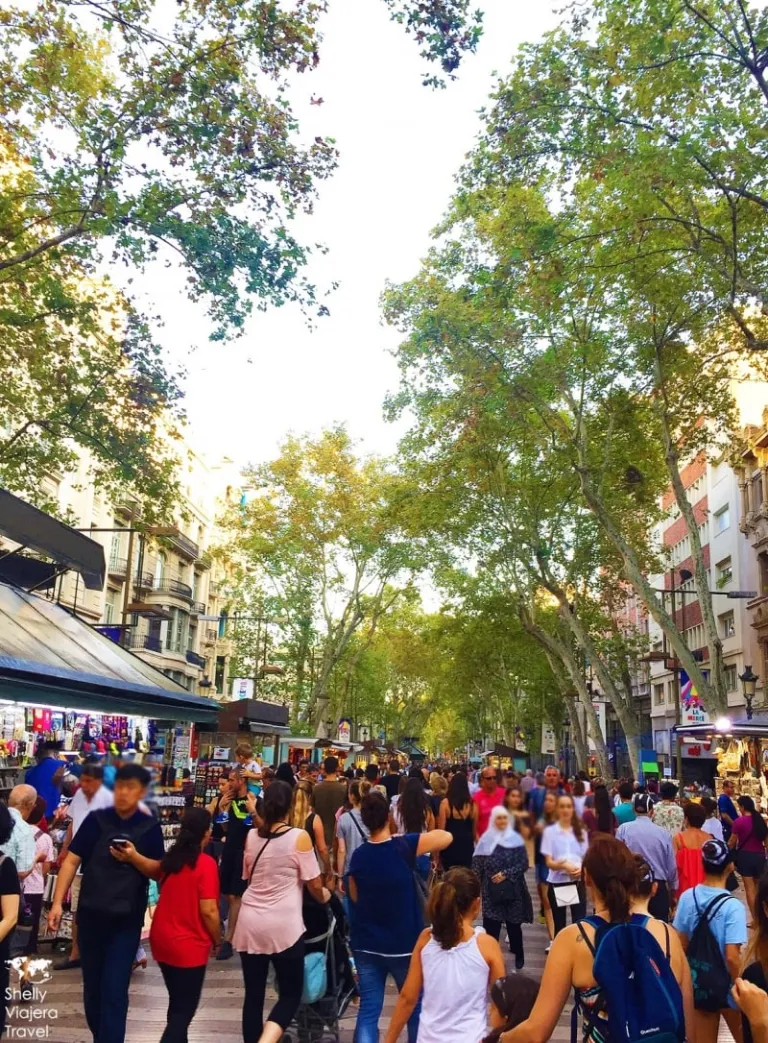
Other names: Las Ramblas (ESP)
Part of the old district, La Rambla is a kilometre stretch of outdoor shops that mostly sell souvenir items. With this, it’s the melting pot of tourists and a very busy place. My straightforward advice, just make sure to watch your bag when walking along La Rambla. Sling your bag and avoid using it as a backpack.
Tip: Most first-timers in Barcelona think La Rambla is the ideal and only place for souvenirs. Honestly, you aren’t getting the cheapest price at La Rambla. What I can advise instead is to head to Carrer de la Portaferrissa, which is five minutes from La Rambla (check the map above), where you can get the same but cheaper souvenirs.
4. La Boquería

To experience the local public market scene, go to La Boquería. It’s well-visited by tourists as it’s one of the first established markets in Barcelona. It humbly started as a small goat meat shop, which is why it was named boqueria with boc which means goat in Catalán.
It has an entrance not far from the La Rambla. Inside La Boqueria, you’ll find an array of meat shops selling jamón, chorizo, fuet, and other Spanish cold cuts. It also sells other products that you commonly see in other public markets.
Entrance: Free
Operating Hours:
Mondays-Saturdays: 8.30am-8.30pm
Closed on Sundays and holidays
5. Barcelona Cathedral

Other names: Catedral de Barcelona (ESP)
Aside from the Sagrada Familia, there are smaller Catholic churches throughout Barcelona that also deserve a visit. One of which is the Barcelona Cathedral, which has a beautiful Gothic façade. It’s a 13th-century cathedral dedicated to Eulalia, one of the two patron saints of Barcelona.
The cathedral is open all-day for worship and prayer. However, for cultural visits, it’s only open to visitors from afternoon to evening.
Entrance: Free
To visit the roof and the choir, there’s an entrance fee of €3 each.
Operating hours (for cultural visits):
Weekdays: 12.30pm-7.15pm
Saturdays: 12.30pm-4.45pm
Sundays: 2pm-5.30pm
6. Gothic Quarter
Other names: Barri Gòtic (CAT) / Barrio Gótico (ESP)
This is the same area where the Barcelona Cathedral is. The Gothic Quarter is considered the heart of the old city of Barcelona. Back in the day, it used to be a Roman village that consists of maze-like narrow alleys.
A famous spot here is the Pont del Brisbe located at the narrow street of Carrer del Bisbe. It’s a bridge that dates back to medieval times.
It’s a good spot to end the day because of the plaças. These are basically small plazas that turn into outdoor cafes in the afternoon until evening. One of the most popular plazas in the area is the Plaça Reial.
Day 3: Casa Batlló, Casa Amatller, Casa Milà, Mirador de Colom, Plaça d’Espanya, Montjuïc
1. Casa Batlló (Batlló is pronounced “bat-cho”)
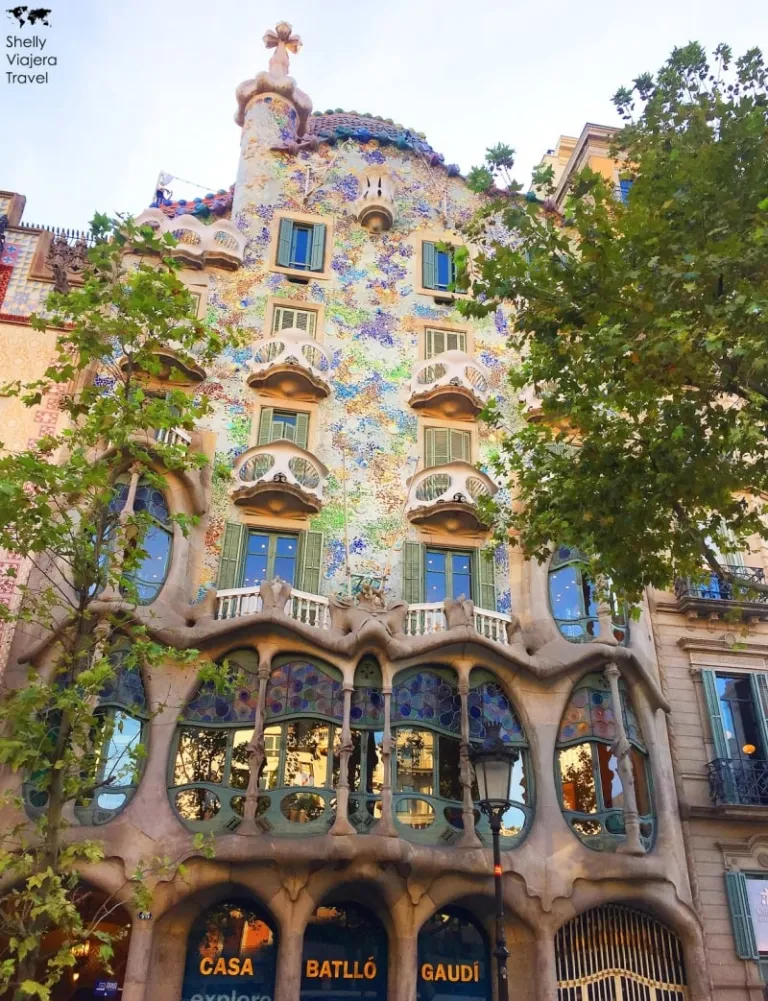
In 1860, a visionary urban plan was launched in Barcelona. This made prominent families move to Passeig de Gràcia, an upscale street in Barcelona. For one, a textile businessman Josep Batllo bought a house in the area and then years later, he let famous architect Antoni Gaudi remodel his house.
With such cultural significance as one of the masterpieces of Gaudi, Casa Batlló became a UNESCO World Heritage Site and is one of the well-visited spots in Barcelona. It’s for the architecturally passionate and those who appreciate modernism. Though in my opinion, access to the house comes with a hefty price.
Prices:
Online: €24.5 with audio guide
Counter fee: €28.5 with audio guide
Online: €29.5 with audio guide and fast pass
Operating hours: 9am to 8pm
2. Casa Amatller
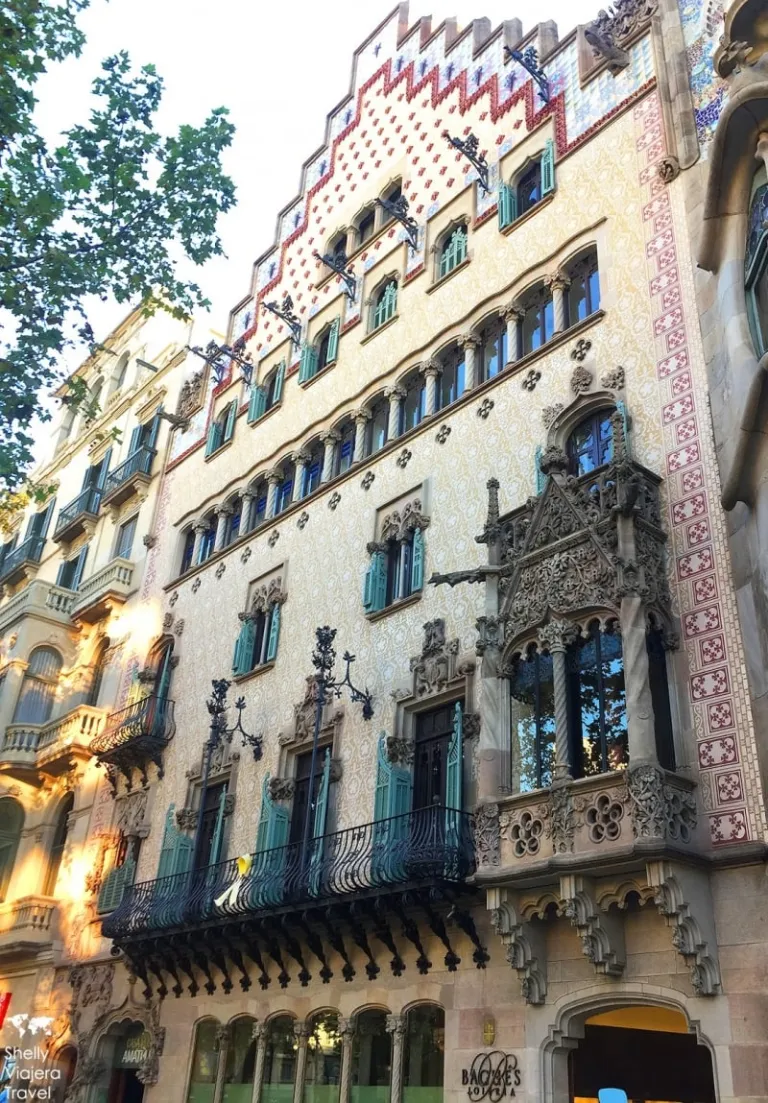
Right beside Casa Batlló is another famous house in Barcelona. The Casa Amatller once belonged to chocolatier Antoni Amatller Costa, who then, let modernist architect Josep Puig i Cadafalch remodel the five-story house.
Similar to Casa Batlló, the house is filled with modernist art. Though what makes it different is that when you choose to enter Casa Amatller, there’s an included cup of chocolate!
Prices:
Self-guided: €19
Audio-guided: €24
3. Casa Milà
Other names: La Pedrera (ESP)
The Casa Milà is a house owned by Pere Milà and her husband Roser Segimon. It’s also located at Passeig de Gracia, remodelled by Antoni Gaudi, and named a UNESCO World Heritage Site.
Some people also call it La Pedrera, which means “stone quarry” in English, since the exterior design looks like one. Back then, the house faced negative criticisms for being unusual and not following conventional building codes, and there were rumours of an affair between Gaudi and Pere Milà.
Price: €22
Operating hours:
March 1-November 4 and December 26-January 3
Monday-Sunday: 9am-8.30pm
Night tour: 9pm-11pm
November 5-February 28
Monday-Sunday: 9am-6.30pm
Night tour: 7pm-9pm
4. Mirador de Colom
Other names: Mirador de Colón (ESP) / Columbus Monument (EN)
The Mirador de Colom is a monument in honour of Christopher Columbus, who chose to disembark from the Port of Barcelona during his first voyage to the Americas. The monument is located at the end of La Rambla, an area towards the seaside of Barcelona.
It’s a detailed sculpture, featuring an image of Columbus situated on top and who’s pointing where the New World is said to be.
5. Plaça d’Espanya

Other names: Plaza de España (ESP)
The Plaça d’Espanya is a big square that serves as junction of different big roads in Barcelona. The two Venetian Towers are also found in Plaça d’Espanya, which mark the entrance to Montjuïc.

Plaça d’Espanya is historical as it used to be the centre of bullfighting, which took place in the Plaza de Toros de las Arenas. However, when the sport was banned in Barcelona, the arena was converted into a commercial space. Now, it’s a shopping mall with an amazing rooftop view.
6. Montjuïc
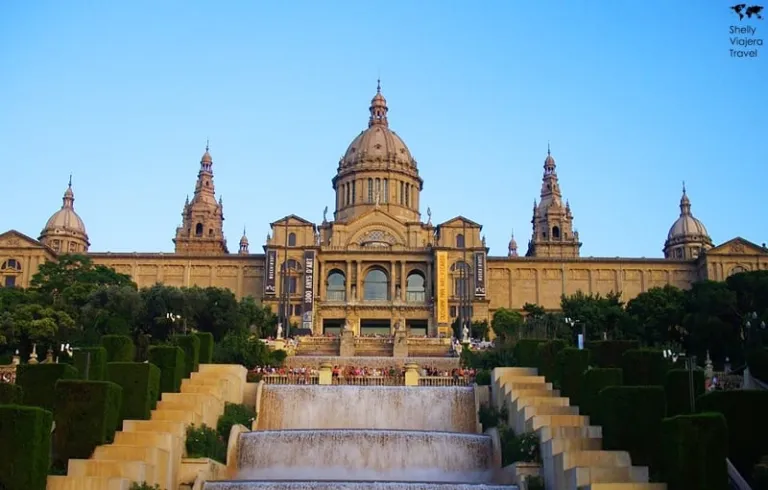
Montjuïc is a hill in Barcelona. A visit there offers a lot of activities, featuring the Montjuïc Castle, museums like the Museu Nacional d’Art de Catalunya (MNAC) and Poble Espanyol, and the Font Mágica, a huge musical fountain that has an amazing light show at night.
There’s also a cable car ride to Montjuïc priced at €8.40 one-way and €12.70 for a two-way ride.
Also read: Our Ultimate Europe Trip: 10 Countries & 15 Cities in 27 Days
See more of Barcelona
People usually visit Barcelona in three to four days. But given the luxury to spend more days in Barcelona, you may also take time visiting these places:
Montserrat Monastery
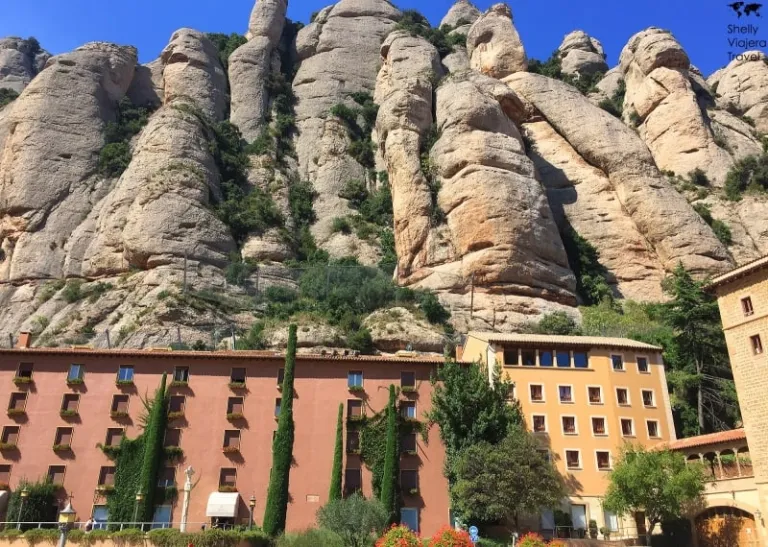
Located northwest of Barcelona, Montserrat is a monastery surrounded by beautiful and unique rock formations of the Benedictine monk mountain. It’s known for the black-faced Madonna, called the Morenata, that’s said to be miraculous. Another attraction here is the Gregorian chants by the choir boys who perform inside the basilica.
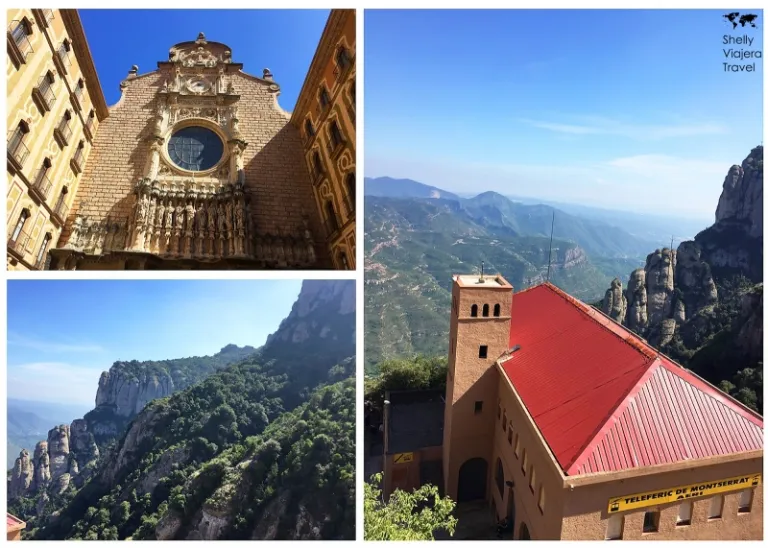
Monserrat is far from downtown and is usually arranged with a guided tour. Still, public transportation is available by taking a combination of train + cable car/funicular ride.
How to get there by public transportation:
From Plaça d’Espanya station, take line 5 towards Manresa to bring you to the foot of Montserrat. Once there, choose between the Aeri de Montserrat (cable car) or the Cremallera Funicular (funicular) to go up the monastery.
Temple of the Sacred Heart Jesus
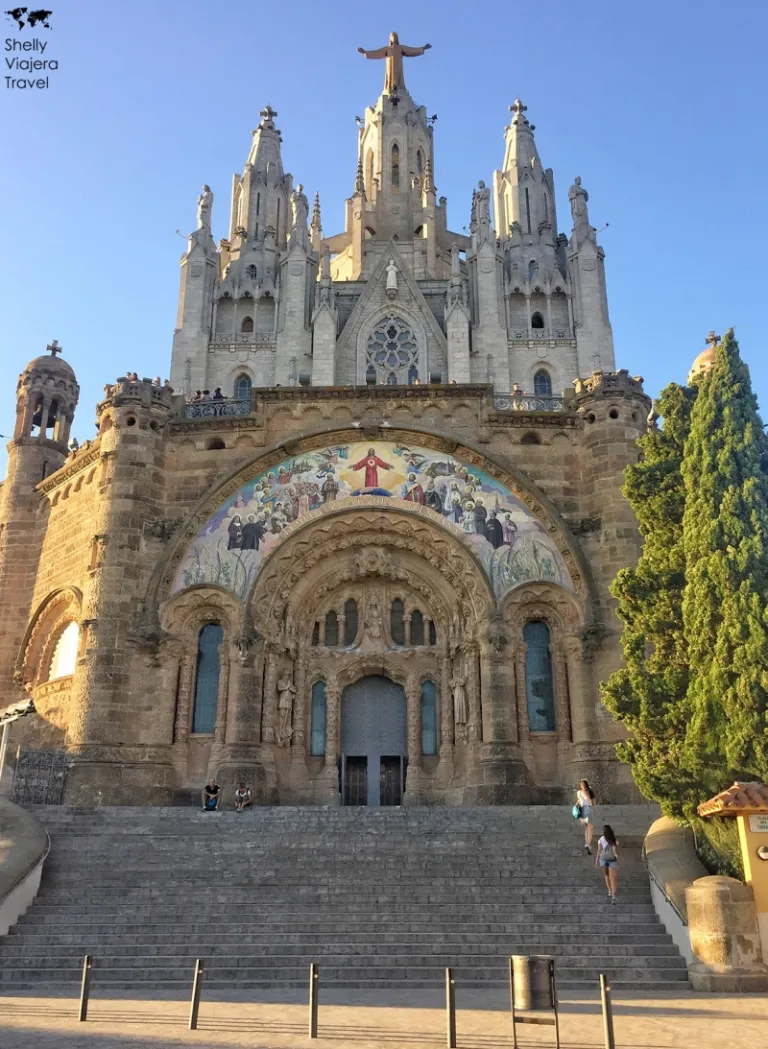
Other names: Temple Expiatori del Sagrat Cor de Jesús (CAT) / Tibidabo Church (EN)
This church is located at the highest point of the city: Mount Tibidabo. It’s located northwest of Barcelona that’s usually accessed by car or guided tour as there’s no direct route via public transportation.

Given the height, it offers a breathtaking view of Barcelona. Aside from the church, the Tibidabo Amusement Park sits beside it, which is one of the earlier theme parks of the city.
How to get there by public transportation:
From Plaça de Catalunya metro station, take S1 or S2 then alight at Peu del Funicular. Then, take the Vallvidrera Funicular and finally take bus 111 to reach Tibidabo.
Barceloneta
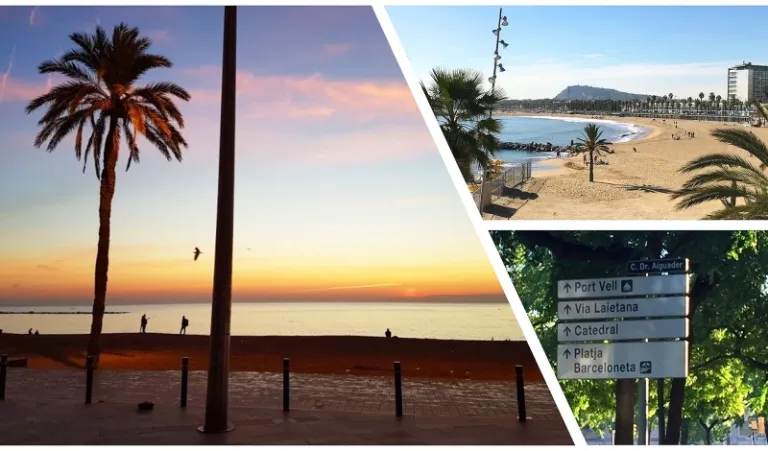
What’s great about Barcelona is that it’s surrounded by the sea. Located in the Ciutat Vella neighbourhood, Barceloneta is perhaps the nearest beach you can head to while in the city centre.
Barceloneta is a tourist spot especially during the summer from June to August. It’s surrounded by seaside bars and restaurants where it’s said to get the best seafood paella.
Ways to get there:
-Take the BCN metro line 4 and alight at Barceloneta station
-Buses 39, 45, 59, 64, V15, D20 have a stop at Barceloneta
Camp Nou
Whether a football fan or not, a trip to the Camp Nou would be interesting as it’s the home stadium of the Barça team (*screams Messi!*), also known as the Futbol Club Barcelona (FCB).
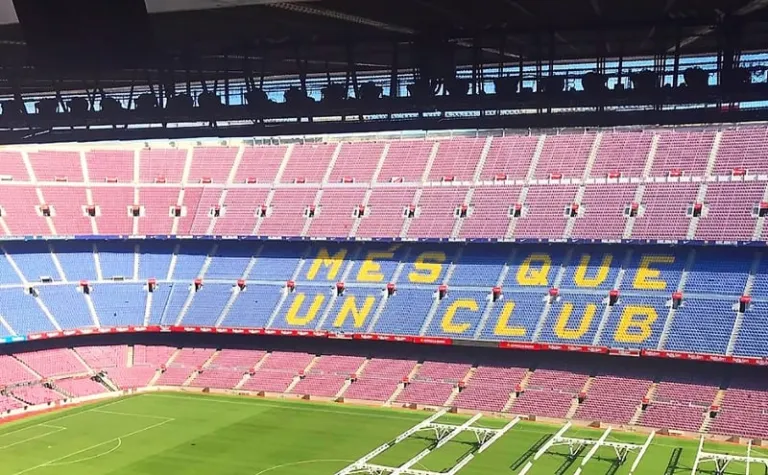
Even if there’s no football match, Camp Nou has its doors open to tourists. There are different Camp Nou tours available (starting at €25) that give access not only to the stadium but also to the Barça Museum, which is said to be the second most visited museum in Barcelona next to the Picasso Museum.
Ways to get there:
– Take the BCN L3 and alight at either Palau Reial, Maria Cristina, or Les Corts station or line 5 and alight at either Badal or Collblanc station
– Take the tram and alight at Avinguda de Xile Station, served by lines T1, T2, and T3
– Buses 7, 15, 33, 54, 56, 57, 63, 67, 74, 75, 78, 113, 157 have a stop at Camp Nou
Published at
About Author
Shelly Dimaculangan
Subscribe our Newsletter
Get our weekly tips and travel news!
Recommended Articles
10 Best Things to Do in Los Angeles 10 Commandments for Responsible Travel Flexing Spread the good word!
10 Cutest Cafes in Japan That Are Totally One of a Kind From Pikachu snacks to Totoro cream puffs, here are 10 themed cafes in Japan that prove café hopping should be part of your travel itinerary.
10-day Christmas and New Year Japan Trip: Complete Travel Itinerary Celebrate Christmas and New Year in Japan with this 10-day holiday vacation itinerary packed with Tokyo lights, Kyoto charm, and Osaka adventures.
10 Fairytale Castles In Europe Filipinos Need To See! Permission to feel like royalty even for a day?!
Latest Articles
Thailand Eyes to Build Disneyland Instead of Casino Complex Thailand is considering bringing Disneyland to the country, replacing a previously proposed casino and entertainment complex.
US May Require Five Years of Social Media History for Tourists Are Filipino tourists affected?
3 Days in Okinawa: Everything We Saw, Did, and Ate in Japan's Southern Gem Here's your ultimate travel guide to Okinawa, Japan!
Cheap Domestic Flights Needed as Philippines Ranks Last in Southeast Asia Tourism Tulfo says local flights are too expensive and Filipinos deserve better travel deals.
The Quiet LA Travel Hack Travellers Should Know: Why Flying Into Ontario Airport is Way Better Here's how to get to LA without going through LAX!

